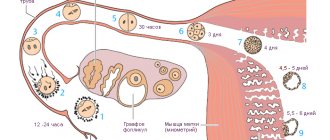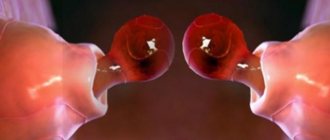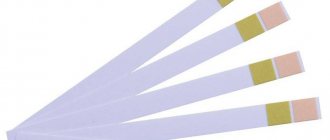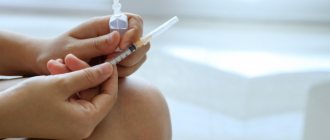Determining the time of ovulation is a very important point for every married couple who is planning the birth of a baby. Modern technologies have reached the point that you can determine the period of ovulation using a special microscope that provides information from your saliva. In this article we will look at the types of such microscopes, their technical characteristics and other parameters in order to choose the best option.
How to use an ovulation test?
Many girls and women can feel the onset of ovulation.
These days, as a rule, vaginal discharge becomes more viscous and abundant, libido may increase slightly, pain is felt in the ovary - this is how nature provides the mechanism for conception. But to be one step ahead, you need to do an ovulation test. This will allow you to determine the period of maximum fertility of a woman, that is, select the most favorable moment for conceiving a child. Ovulation is the release of a mature egg from the follicle into the fallopian tube. If by this time a nimble, viable sperm is already waiting for her here, then this meeting will end with the fusion of male and female cells and the formation of a zygote, which will continue its journey to the uterus and settle there for its further development.
To determine the moment of release of the egg and provide it with fresh sperm, it is very convenient and effective to use an ovulation test. It helps the couple choose the most successful period for conception.
Ovulation can be determined using a home test. The principle of its action is based on determining the level of luteinizing hormone (LH) in a woman’s urine. This hormone is also produced in men, but in them it is always at a stable level.
In women, LH levels depend entirely on the period of the menstrual cycle. It reaches its maximum levels on the eve of ovulation.
Special tests make it possible to record this rise, which will be evidence of the onset of ovulation in the next few days after receiving this result.
An ovulation test works on the same principle as a pregnancy test, only here the reagents of the cassettes and strips react not to hCG, but to LH. There are also devices on sale for determining ovulation using saliva. They are designed for reusable use, but are also much more expensive.
An increase in the level of luteinizing hormone to values that can be recorded by the test indicates the onset of ovulation in the next 12-48 hours (usually we are talking about a day or two). For sexual partners, this indicates the most favorable time for conceiving a child.
Some girls use the ovulation test for the opposite purposes: they determine the days on which safe sex must be abandoned, that is, they use it for protective purposes. But pharmacists note that the direct purpose of an ovulation test is still to determine the period of maximum fertility of a woman.
Most ovulation tests contain 5 strips or tablets, although single strips are also available. This is explained by the fact that it is extremely rare to determine ovulation the first time, and repeat testing increases the chances.
Testing should begin on the eve of expected ovulation. To more accurately determine this day, there is a simple formula: the duration of your menstrual cycle minus 17 days.
That is, with a 28-day cycle, testing should begin on the 11th day.
Detailed testing instructions are included in each package for the different tests. It must be followed without violations in order to obtain true test results. There is nothing complicated here: the strip is placed in a container with urine or placed under the stream. You must repeat the procedure every day at the same time until you get a positive result.
In order not to distort the results, it is recommended not to drink much liquid for 1-4 hours before the test and to refrain from urinating for at least 2 hours. Also, the first morning urine sample should not be used for testing. It is best to carry out the procedure during the day, from 10 am to 8 pm.
When you take an ovulation test, you may get one of several possible results:
- the absence or very weak test strip (much lighter than the control) is considered a negative result, that is, there is still a long time before ovulation;
- a pronounced second test line indicates the onset of ovulation in the next 12-48 hours, and the LH level is higher, the brighter the test line appears:
- the absence of a control strip indicates that the test is unsuitable for use.
A positive ovulation test confirms high female fertility during this period. If you are trying to get pregnant, then you need to plan sexual intercourse in the next 24 hours - this is the best time to conceive. We wish you success!
Recently, various ovulation tests have appeared in pharmacies, offered by several manufacturers. These products have already gained popularity among many women. What are they for, and how can they be useful to the fairer sex?
What is ovulation
Ovulation is the most important moment in the functioning of the female reproductive system.
Ovulation in gynecology means the moment when the egg leaves the ovary and begins its movement along the fallopian tube, where it should meet the sperm.
Since the lifespan of an egg is short - no more than 2 days, the period of ovulation is the most favorable moment for conception.
As a rule, during one cycle (lasting from 21 to 35 days), the egg is released from the ovary only once, but there are cases of double or triple ovulation. However, ovulation is a phenomenon that does not happen every day. And that is why many women strive to find out at what point it will come. Is it possible to do this?
Some women may experience certain physiological signs that indicate ovulation is imminent. This may include slight pain in the lower abdomen, slight vaginal discharge, and increased sexual desire. However, all these signs are purely individual and cannot be used as a reliable criterion.
To determine the moment of ovulation in gynecology, various methods can be used:
- Ultrasound,
- measurement of basal temperature,
- measuring luteinizing hormone levels.
Particular attention should be paid to the last method. It is quite simple and at the same time effective, which made it possible to develop a number of tests based on it that can be used at home.
Luteinizing hormone (LH) is a hormone that is synthesized in a woman’s body immediately before ovulation (one to two days). Thus, its increased concentration may indicate that ovulation will take place in the coming days. The highest concentration of the hormone is found in urine or saliva.
Due to this circumstance, several portable systems have been developed to detect hormone concentrations. The chemicals contained in these systems react with LH and make its presence known through visual signals.
It is enough to moisten one such strip in urine, and in a few minutes it will give the result.
The appearance of a strip on a piece of paper will mean a high level of the hormone and, as a result, a high probability of ovulation within a few days.
In order for an ovulation test to show the correct result, a woman should follow a few simple rules. Firstly, you should not use the very first urine after waking up for testing.
The optimal time for urine collection is from 10.00 to 20.00. In addition, you should not drink a lot of fluid before urinating, as this can dilute the urine and reduce the concentration of the hormone.
In addition, repeat testing is recommended to increase the reliability of the results.
What can an ovulation test be useful for? Firstly, it can be useful for women who passionately want to get pregnant. After all, ovulation and the few days preceding it are the most favorable period for conception.
Some women use tests as a means to plan the sex of their child.
There is a theory according to which sperm carrying the male chromosome are less tenacious, but more mobile compared to sperm carrying the female chromosome.
In other cases, an ovulation test can be used by women who, on the contrary, want to avoid pregnancy. After all, after two days after ovulation, sperm will no longer be able to fertilize the egg.
However, this method requires more frequent testing, and given that test strips cost some money, it is associated with some material costs. In addition, this method of protection cannot be called very reliable. After all, ovulation tests report only the concentration of LH, and not the moment of ovulation itself.
Not to mention the high probability of obtaining false negative results due to non-compliance with the testing methodology or poor-quality (expired) test strips.
In total, the pharmaceutical industry produces several testing systems:
- using disposable strips,
- using disposable cartridges,
- jet systems,
- electronic devices with disposable strips,
- optical instruments for determining LH from saliva.
Testing with disposable cartridges is much like testing with strips. The only difference is that a drop of urine must be dropped into one window of the cartridge, and the result will be displayed in the other window.
The device with disposable strips is similar in principle to devices for testing blood sugar levels. A strip soaked in urine is inserted into a special connector, and the test result appears on the indicator. Read on the official Frautest website about what types of ovulation tests exist.
Let us describe in more detail the method of testing for PH using disposable strips (strip tests). The most popular ovulation tests of this type are produced under the brand names Frautest, Eviplan, Solo.
Typically, an ovulation test includes several strips for testing for LH. Some also come with additional pregnancy test strips.
- It should be understood that the test does not directly indicate the release of an egg from the ovary, but only detects elevated LH levels. Those. with a positive ovulation test, a hormonal surge is noted, which indicates the release of a mature egg in the coming hours.
- The highest level of LH lasts less than a day, so it is recommended to carry out diagnostics 2 times a day (morning and evening) in order to be more likely to catch this moment.
- You should not drink a lot of liquid three to four hours before testing, so as not to dilute your urine.
- When using a digital test with saliva, be sure to check the result obtained with the control picture.
All women are familiar with pregnancy tests, which, thanks to a special zone of sensitivity to human chorionic gonadotropic hormone (hCG), make it possible to determine whether there is the presence of this substance produced by the chorion of the embryo in a woman’s urine. The ovulation test works in a similar way, but it does not react to hCG (this is the pregnancy hormone), but to other hormones that regulate the ovulation process in the female body.
The hypothalamus, which regulates the functioning of the pituitary gland, is responsible for changing periods of the female cycle in the body of representatives of the fair sex. At the right time, the hypothalamus gives a clear command to the pituitary gland to produce certain hormones, under the influence of which the processes of maturation and release of the oocyte from the follicle will occur. If the egg does not mature, if it cannot leave the follicle, then conception will not occur in principle.
The pituitary gland releases two hormones into the blood in the first half of the female cycle - FSH (follicle-stimulating, affecting the maturation of the germ cell) and LH (luteinizing, under the influence of which the follicle ruptures). FSH causes the follicle to grow until its size reaches a critical size - up to 2 centimeters in diameter.
While the follicle is gaining size, it stimulates the production of estrogen. Under their influence, the pituitary gland begins to produce LH (luteinizing hormone) at an accelerated pace. This process is called the ovulatory LH surge by laboratory technicians and physicians. From the moment this peak is recorded until the follicle ruptures and the female reproductive cell is released ready for fertilization, 36 to 48 hours pass.
The ovulation test has a sensitivity zone (test zone) with an applied substance that is sensitive to luteinizing hormone. Accordingly, the higher the concentration of this substance in the body of a representative of the fair sex, the faster the sensitive zone will be able to determine this and show the woman whether ovulation is approaching or has already occurred.
When should you take an ovulation test?
Manufacturers indicate the high accuracy of the test. The device looks quite solid; it consists of a plastic case and a testing module. According to the instructions, the module is inserted into the case, after which a blinking signal should appear on the case. This means that the system is ready for use.
Urine should be collected in a clean container, after paying attention to the hygiene of the external genitalia. The sampler is immersed in urine for 10-15 seconds, but it is important not to wet the body itself. Then place the system on a flat, dry surface and after about 30-40 seconds the test will begin to blink, signaling that it is fully operational. In another couple of minutes the result will be ready. An empty circle means that the time for conception is unfavorable.
A smiling emoticon in the test window is a positive result. The strip is thrown away. For next use, insert a new one.
"Frautest"
This is a more economical and budget option. Manufacturers of test strips (strip tests of this brand) approach their business quite responsibly, and therefore their products have proven themselves long ago and reliably among women all over the world. Any of the Frautest kits contains 5 strips. The cost of the sets is from 400 to 500 rubles. A nice bonus is two strips of the same brand, but for determining pregnancy from the first day of a missed period (you won’t have to buy pregnancy tests separately later!). And another nice bonus - 7 small containers for urine (you don’t have to look for a convenient suitable container to collect it).
The use is simple and understandable even on an intuitive level. The strip is immersed in the urine sample to the line marked on the strip. After five seconds, take it out and place it on a dry surface to dry. After 10 minutes you can read the result. It is standard: two stripes - positive, one - negative. Each strip is intended for one use only.
If for some reason the pharmacy does not have a strip system from this particular manufacturer, you can replace it with “Eviplan”, “Ovuplan”, “Femiplan” strips without much damage to the result.
Cassette tests
A huge advantage of such tests is their reusable use, and therefore they can be safely chosen by those who have been planning a pregnancy for a long time and have tried a lot of disposable tests. This will save you money in the long run. They are easy to do - you place the cassette under a stream of urine and after 5-10 minutes you can read the result, which looks like one or two stripes.
This is a very accurate test, but it is considered the most expensive and therefore less popular, and therefore there are not as many real user reviews about it as we would like to get a clear picture of the pros and cons. Brands such as Femotest, Fertile Focus mini-microscope, Eva-testD, OVU-test, MaybeMom and some other brands are available for purchase.
It is used simply: apply a little saliva to the glass of the microscope, wait for it to dry and carefully examine it through the microscope. If the pattern resembles fern leaves, ovulation is already very close. Reusable device, cost from 2 to 4 thousand rubles.
Pregnancy is a happy time, but conceiving a child is not always possible. There are many ways to help you get pregnant, but the simplest of them is an ovulation test, which any woman can do without leaving home.
An ovulation test is a diagnostic method used at home that allows you to determine the most favorable days for conception. The female body has certain physiological characteristics.
From month to month, each representative of the fair sex repeats the same cycle: an egg matures in the ovary, after which it exits into the fallopian tube and begins to move towards the uterus. Fertilization can occur only in the first two days after the rupture of the follicle, then the germ cell dies.
All these changes are accompanied by hormonal fluctuations, in particular, a sharp jump in LH (luteinizing hormone). It is on measuring its level that ovulation tests are based.
Ovulation tests are used not only to determine favorable days for conception. They are also used for medicinal purposes and as a way to prevent pregnancy.
There are several types of ovulation tests:
- disposable test strips;
- disposable cassette;
- disposable digital;
- reusable devices.
Disposable test strips are very similar in appearance to pregnancy tests. They are easy to use and inexpensive. But their disadvantage is the ambiguity of the result: the test line can be unclear, so determining ovulation is often difficult.
The principle of operation of ovulation test strips is the same as that of pregnancy tests.
The cassette test is a classic test strip, but enclosed in a plastic case. On one side there is a window in which the result is visible, and on the other there is a hole that needs to be placed under a stream of urine or the collected biological material should be dropped into it from a pipette.
Cassette ovulation tests are the same test strips, but enclosed in a plastic case
Digital ovulation tests are also disposable, but at the same time they are highly convenient to use, since a woman does not need to peer at the strips, compare them by brightness, but simply look at the screen, which will show an unambiguous result. In this case, the device remembers the obtained LH levels and compares them with each other, which allows you to most accurately determine the release of an egg from the ovary.
The digital ovulation test includes an electronic device with a display and several test strips
Reusable ovulation tests are made in the form of a powder compact or lipstick. To determine the release of an egg from the ovary, they examine saliva, which, under the influence of hormones on days favorable for fertilization, has the structure of a fern when viewed under a microscope. Such devices include:
- Ovulux microscope;
- MaybeMOM microscope;
- Vesta device;
- Loupe microscope;
- OVU microscope;
- microscope Arbor-elite;
- Eva-test device.
To be fair, it is worth noting that such tests cost a lot, and there are few real reviews about them.
The Vesta device examines a woman’s saliva and reports the result using a light signal. The MaybeMOM device allows you to examine saliva under a microscope and determine ovulation by its structure. When an egg is released from the ovary, under the influence of hormones, saliva crystals line up in a certain structure, reminiscent of fern leaves
It is impossible to find out about ovulation using a pregnancy test. The fact is that the hormonal background after conception and the release of the egg from the ovary is completely different, and diagnosis is based precisely on determining the amount of a particular hormone in the blood:
- during ovulation, the level of LH (luteinizing hormone) increases;
- after conception, a surge of hCG (human chorionic gonadotropin) is observed.
An ovulation test should be done on certain days, the choice of which depends on the length of the woman’s cycle. In order to determine the desired date, you need to subtract 17 from the duration of the menstrual cycle. For example:
- if a woman’s menstrual cycle lasts 26 days, then 26–17 = 9, that is, testing is recommended on the ninth day after the start of menstruation;
- if a woman’s menstrual cycle lasts 28 days, then 28–17 = 11, that is, testing is recommended on the eleventh day after the start of menstruation;
- if a woman’s menstrual cycle lasts 32 days, then 32–17=15, that is, testing is recommended on the fifteenth day after the start of menstruation.
But what should women with irregular periods do? They need to calculate the average cycle length using the last three months as a basis.
For example, if the first menstrual bleeding began after 26 days, the second after 32, and the third after 30, then (26 32 30)/3=29, that is, the average cycle length is 29 days, which means you should start doing ovulation tests needed from the twelfth day (29–17=12).
Since the release of the egg most often occurs in the middle of the cycle, it is advisable to begin testing 2-3 days before the expected date of follicle rupture.
The number of tests in a package varies: 5, 7 and even 20 pieces. For women with a regular cycle, five is enough; for women with an irregular cycle, it is better to buy seven. And only digital devices are equipped with twenty test strips.
Using an ovulation test will speed up pregnancy
When a couple dreams of a child, catching the moment the egg leaves the follicle means catching luck by the tail. The instructions recommend performing an ovulation test several times during the cycle with a 12-hour break. This approach will allow you to find out as accurately as possible the favorable day for conception.
An ovulation test is necessary to identify the fertile period. During this period, the woman is completely ready for fertilization, and the likelihood of conception increases significantly. Any gynecologist will tell a couple planning a pregnancy why it is necessary to know fertile days. This is the basis of pregnancy planning.
- hormonal diseases;
- overweight or underweight;
- bad habits;
- exposure to stress, lack of sleep and chronic fatigue;
- ovarian depletion;
- taking certain medications.
- A positive test tells us that in the next few hours the egg will be released from the ovary, mature and ready for fertilization.
- The egg lives only 24 hours after leaving the reproductive gland.
- Thus, you should not start conceiving immediately after a positive test; you need to pause for several hours, allowing the egg to leave the ovary. Optimal time: 5-10 hours after diagnosis, not forgetting that the egg only lives for a day.
- There is no point in delaying this moment until the last hours of the cherished day, since fertilization itself does not occur immediately immediately after sexual intercourse, but several hours later, during which the sex cells move towards each other.
Appliance brands
Ovulation microscopes are produced by different companies. All models have a common operating principle. They differ only in the nuances of care and the presence of additional functions. The approximate price of the device is 2500 rubles.
Оvulux
Ovulux is the most famous type of microscope test for ovulation in Russia. This popularity is due to a number of advantages of the device:
- Quick result: the study only takes 5 minutes;
- Accuracy of “readings”: according to manufacturers, it reaches 98%;
- Compact and unusual packaging: an uninitiated person will mistake a microscope for a woman’s lipstick;
- Can be used as a contraceptive: do not use protection on “safe” days;
- A convenient device that does not require additional equipment for research.
“Determines” the gender of the unborn baby with an accuracy of 80%. Intimacy on the day of ovulation will result in the birth of a boy. Successful fertilization the day before the “peak” of the egg’s journey through the fallopian tubes will lead to the birth of a girl.
The microscope is manufactured by the South Korean company Saejin Corp. All equipment is made of high quality materials:
- Lens system;
- Glass for applying biological material;
- LED lights;
- Battery.
The device does not require preparation for use. Apply 1-2 drops of saliva onto the glass. Wait 3-5 minutes (until the biological fluid is completely dry) and insert the glass into the device. To make it easier to see, turn on the backlight.
The drawings in the instructions will help you evaluate the diagnostic result.
In the package with the Ovulux microscope you will find a nice bonus: the “Women’s Calendar” mobile phone program. By installing it on your phone, you can track important days of your menstrual cycle. The calculation results are saved in the program, which allows you to create a special schedule of days that are favorable and unfavorable for conception. In addition, the stored information allows the application to identify cycle patterns, which it will immediately inform its “mistress” about.
Your cycle
This microscope has no additional features. It is just as easy to use as its Korean brother. Looks like an elegant tube of lipstick and guarantees the most accurate result.
However, users are advised to purchase this microscope on the manufacturers’ official website. After all, this device is often counterfeited. And official representatives of the company give a lifetime warranty on use.
Arbor Elite
No less popular is a microscope for determining ovulation called Arbor-Elite. The technical characteristics and operating principle of the device are identical to other microscopes for determining ovulation. The only important difference is the presence of replaceable glass. There are 32 of them in the set. They help to “visually” track the entire cycle, preserving glass with a changing pattern on it.
Watch a video review of the Lady-Q model
Types and characteristics
There are a wide variety of ovulation tests, and a woman who turns to a pharmacy with a corresponding question may be faced with the problem of which test is best to choose. Of course, you have to find the answer to this question yourself: for some it is important that the test system be highly sensitive, for others the issue of cost is important and a cheap pharmacy test is needed. We will tell you about the types and give brief characteristics.
- Rapid tests in the form of strips (the so-called “strip” tests) are very popular and, perhaps, the most sought-after type of ovulation test systems. These are paper strips with a reagent applied in the test sensitivity zone, which is colored when determining the high content of luteinizing hormone in the urine. The advantages of the test are that it is convenient to use; no special medical knowledge is required to understand its results. It is only important to follow the instructions.
- Tablet (cassette) test - looks like a plastic case with two miniature windows. The task of the woman being tested is to drop a few drops of urine into the first window using a special pipette and wait until the result appears in the other. The test with two strips will respond to the increased quantitative presence of the LH hormone in the fluid secreted by the kidneys.
The advantages of the system are that there is no need to specifically collect urine into a clean container, and also that the reliability of the result is slightly higher than that of a regular paper strip. The downside is that it costs more than express stripes.
- A reusable test is an electronic device that can be used more than once. Equipped with replaceable strips for determining LH in urine, the accuracy is considered quite high. The cost is also not low.
- The jet test is a highly sensitive test system that allows you not to collect urine, but simply to place the test under the stream while emptying the bladder. After a few minutes, the result appears on the test.
- The digital system is not even a test in the broad sense of the word, but a small microscope that looks like a tube of lipstick. Allows you to determine the approach of ovulation by saliva and vaginal secretions. Under the influence of estrogen, a woman's saliva in the period immediately before ovulation, when dried, begins to resemble the pattern of a fern leaf or a frosty pattern on glass.
Vaginal secretions behave similarly. Pros: fairly high accuracy and reusability. The disadvantages are the high price and a lot of room for a woman’s imagination, which sometimes allows her to see something that is not there, where it is not supposed to be.
Saliva analysis
The device can be used repeatedly. Mini microscopes have small dimensions. In their shape and size, they are similar to a package of mascara or a tube of lipstick. Such devices are used to determine the period of the onset of ovulation approximately 4 days before its onset.
This information is directly related to the structure of a woman’s body. About 2 days before the start of ovulation, a woman’s body begins to produce estrogen in very large quantities. It inhibits the release of potassium and sodium from the body, therefore, the composition of saliva changes.
Testing rules
If you use the test correctly, without violating the requirements of the instructions for use, you can get results that will be accurate enough for planning conception. But the difficulty lies in proper use - many women make mistakes and get unreliable results. To avoid this, you need to know how to do such testing correctly.
The vast majority of disposable tests (the most common) have five test strips inside the box. Why five? Because you can establish the fact of pregnancy by 1-2 stripes after a delay, but guessing the best time to test for ovulation is not so easy, and repeated testing may be required. In addition, repeating the procedure helps improve the accuracy of diagnostic self-test.
So, you bought the test and are now wondering when to start taking it. There is no point in conducting an independent study immediately after menstruation - we remember that luteinizing hormone appears before ovulation as the follicle grows, and therefore it is worth calculating the testing time, focusing on the duration of your cycle. Gynecologists recommend using the formula O = A-17, where O is the preovulatory period, and A is the duration of the cycle.
Example: a woman's menstrual cycle lasts 28 days. From 28 we subtract 17, we get 11. This means that it makes sense to carry out the first ovulation test on the 11th day of the cycle. The countdown begins from the first day of menstruation. Let's say a woman's period started on March 1st. This means that she must take the first test on March 11.
What to do if the cycle is irregular? Here, the advice of experts in the field of women's health is clear: you need to find the average cycle length, taking the last six months as a basis. Let’s say a woman has one cycle that lasts 28 days, another – 30, a third – 29, a fourth – 32 days, and the fifth and sixth are 34 days each. We add these values and get 187. Divide this number by 6 (months) and get the duration of the average cycle for a particular lady - 31 days. Based on the method and formula described above, she needs to start doing tests on the 14th day from the start of her last menstruation (31-17=14).
Before first use, you must carefully read the instructions that came with your purchase. If strips are selected, then the urine is collected in a bowl and the test is dipped into it to the marked level for 15-20 seconds, then the result is waited for 5-10 minutes, placing the test on a dry napkin. The stream test is simply placed under a stream of urine while urinating.
It is recommended to use the next strip at the same time as the first one. To increase the likelihood of an accurate result, it is important for a woman to remember that there are some rules that it is advisable to follow.
- Four hours before the test you should not drink water, tea, or other liquids (this will make the concentration of LH in the urine more objective).
- You should refrain from urinating for at least two hours before testing.
- The time of day matters: unlike pregnancy tests, in which it is advisable to use urine collected in the morning after waking up, it is better to conduct ovulation tests not on this morning portion, since it will contain more hormone, which can lead to a false positive result. It is best to test on subsequent urine samples, any time between 10am and 8pm.
Ovulation tests are generally not recommended for women undergoing in vitro fertilization or hormonal fertility treatments. Any hormone-based drugs change a woman’s natural hormonal background, and therefore self-diagnosis using home tests becomes uninformative or uninformative.
The influence of Duphaston and other agents can lead to false, erroneous results. Therefore, for women with polycystic ovary syndrome and infertility, the IVF protocol when planning conception recommends more accurate methods - a combination of ultrasound and laboratory blood testing for the concentration of LH and FSH.
Erroneous results - what are they and why do they happen?
Deciphering the results of an ovulation test is not difficult. A woman can get several results that cannot be interpreted in two ways:
- negative;
- positive.
If there is basically no second strip in the test zone or it is barely visible, the test should be regarded as negative - there is no luteinizing hormone in the required concentration in the body. This means that the preovulation window has not yet arrived, the testing was carried out ahead of time, or ovulation has already passed (the favorable moment has been missed) - after it, the test also shows a result with a “-” sign.
When there are two lines, the test is considered positive. With this result, a woman should expect ovulation within about 12-48 hours. Pay attention to the brightness of the second strip - the brighter and more distinct it is, the higher the LH level, respectively, the closer the crucial moment. It usually takes about 24 hours from the time two distinct bright stripes appear until ovulation. The result of ovulation testing remains this way for 1-2 days, then if you continue testing, the results again become negative.
Sometimes women get a strange result in which there is not a single strip on the test at all - this means that the test system itself was unsuitable (expired, with violated requirements for storage and transportation conditions). This result can also happen if a woman made serious mistakes in carrying out the self-diagnosis procedure.
The accuracy of ovulation tests can be debated endlessly. Manufacturers claim it is from 97 to 99%. Let's say right away that in reality it is not so high even in expensive electronic tests and reusable mini-microscope systems. In this regard, women often receive false results, which can be influenced by a variety of factors.
A false positive result is getting two stripes when there is actually no ovulation. This sometimes happens when using highly sensitive test systems that are capable of detecting even a slight excess of the level of luteinizing hormone. It is not necessary that ovulation will occur at all in the current cycle (there are anovulatory cycles in the life of any healthy woman), but a slight fluctuation in hormonal levels can be perceived by the test as a positive result. But conception does not occur.
A false positive result may occur in an anovulatory cycle and the result after testing in the morning urine, in which more LH may be present.
A false negative result is a result in which the test shows one line and ovulation occurs. This is possible if the test is carried out incorrectly or the testing rules are violated.
The results must be assessed in strict accordance with the instructions for use.
Basal temperature measurement method
It is also one of the ways to determine ovulation, unlike a test - it does not require spending money, but only requires regular measurement of the temperature in the rectum (every morning before getting out of bed). After menstruation, the basal temperature is usually below 37C, but in the middle of the cycle before ovulation it decreases, and then, if ovulation has occurred, the temperature rises to 37.3-37.6C. The measurement results should be recorded and plotted, this will help the woman determine whether ovulation occurred and on what day.
Benefits of KNOWHEN for pregnancy planning
With your own home lab, you can prepare for the arrival of your new family member. To conduct the study, you only need a saliva sample, from which it will be easy to determine the day of your cycle. The advantages of the device are:
- safety;
- convenience;
- reliability of the result;
- versatility of use.
Long tests in clinics are not always accurate. Due to the large number of people, the results may be mixed up, and you may have to take time off from work to see the doctor. The result obtained with the innovative tester is accurate. In addition, you will be able to control the progress of your pregnancy.









